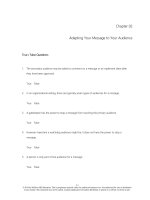Business communication building critical skill 3rd by locker module 2
Bạn đang xem bản rút gọn của tài liệu. Xem và tải ngay bản đầy đủ của tài liệu tại đây (1.06 MB, 18 trang )
PPT
PPT
Module
Module 22
Adapting
AdaptingYour
Your
Message
Messageto
toYour
Your
Audience
Audience
McGraw-Hill/Irwin
©2007, The McGraw-Hill Companies, All Rights
2-2
Adapting
Adapting Your
Your Message
Message to
to Your
Your
Audience
Audience
To learn how to
Continue to analyze your audiences.
Begin to adapt your message to
your audiences.
Begin to understand what your
organization wants.
2-3
Adapting
Adapting Your
Your Message
Message to
to Your
Your
Audience
Audience
Start by answering these questions:
Who is my audience?
Why is audience so important?
What do I need to know about my
audience(s)?
2-4
Adapting
Adapting Your
Your Message
Message to
to Your
Your
Audience
Audience
Start by answering these questions:
Now that I have my analysis, what
do I do with it?
What if my audiences have different
needs?
How do I reach my audience(s)?
2-5
Kinds
Kinds of
of Audiences
Audiences
Initial Audience
Gatekeeper
Primary Audience
Secondary Audience
Watchdog Audience
2-6
PAIBOC
PAIBOC
P What are your purposes in
writing?
A Who is (are) your audiences?
I
What information must your
message include?
2-7
PAIBOC
PAIBOC continued
continued
B What reasons or reader
benefits can you use to support
your position?
O What objections can you
expect your reader(s) to have?
C How will the context affect
reader response?
2-8
The
The Communication
Communication Process
Process
The Communication Model
Perception
Interpretation
Choice/
Selection
Encoding/
Decoding
Channel
Noise
2-9
Audience
Audience Analysis
Analysis Factors
Factors
Empathy
Knowledge
Demographic Factors
Values and Beliefs
Personality
Past Behavior
2-10
Discourse
Discourse Community
Community
A group of people who share
assumptions about
What channels, formats, and styles
to use.
What topics to discuss.
How to discuss topics.
What constitutes evidence.
2-11
Organizational
Organizational (Corporate)
(Corporate)
Culture
Culture
Norms of behavior in
an organization are
revealed
Verbally through the
organization’s myths,
stories, and heroes.
Nonverbally through the
allocation of space,
money, and power.
2-12
Adapting
Adapting Messages
Messages to
to an
an
Audience
Audience
Strategy
Organization
Word Choice
Document Design
Photographs and Visuals
2-13
Gatekeepers
Gatekeepers and
and Primary
Primary
Audience
Audience
To reach, focus on
Content and choice of
details.
Organization.
Level of formality.
Use of technical terms
and theory.
2-14
Written
Written Messages
Messages
Make it easier to
Present many specific
details.
Present extensive or
complex financial data.
Minimize undesirable
emotions.
2-15
Oral
Oral Messages
Messages
Make it easier to
Answer questions, resolve
conflicts, and build
consensus.
Use emotion to persuade.
Get immediate action or
response.
Focus the reader’s
attention.
Modify a proposal
unacceptable in its original
form.
2-16
Communication
Communication Channels
Channels
Channels vary according
to
Speed.
Accuracy of transmission.
Cost.
Number of messages
carried.
Number of people reached.
Efficiency.
Ability to promote goodwill.
2-17
For
For Written
Written and
and Oral
Oral Messages
Messages
Adapt the message to the
audience.
Show the audience how it will
benefit from the idea, policy,
service, or product.
Overcome any objections the
audience may have.
2-18
For
For Written
Written and
and Oral
Oral Messages
Messages
continued
continued
Use you-attitude and positive
emphasis.
Use visuals to clarify or
emphasize material.
Specify what the audience should
do.









